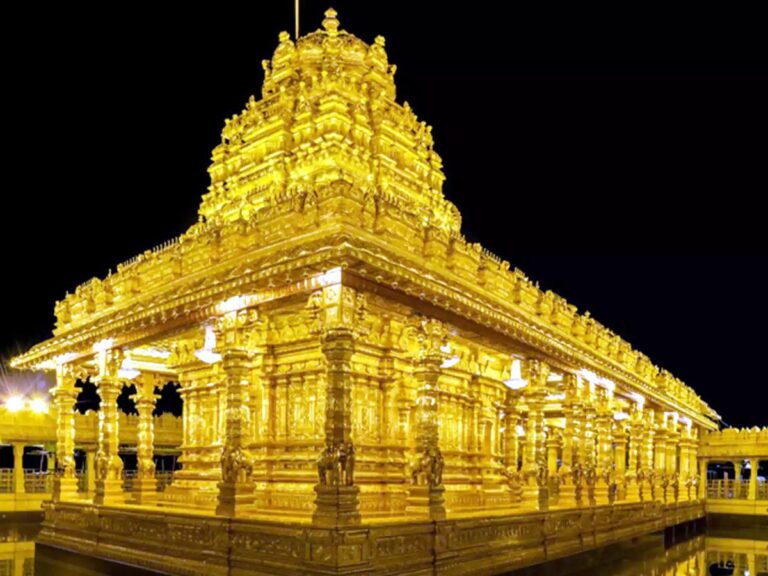Khajuraho Temple: Beyond the Erotic Sculptures
The Khajuraho Temple and its Monuments are a group of Hindu and Jain temples in Chhatarpur district, Madhya Pradesh, India. They are about 175 kilometers southeast of Jhansi. The temples are famous for their Nagara-style architectural symbolism and erotic sculptures, which have been a source of fascination and debate for centuries.
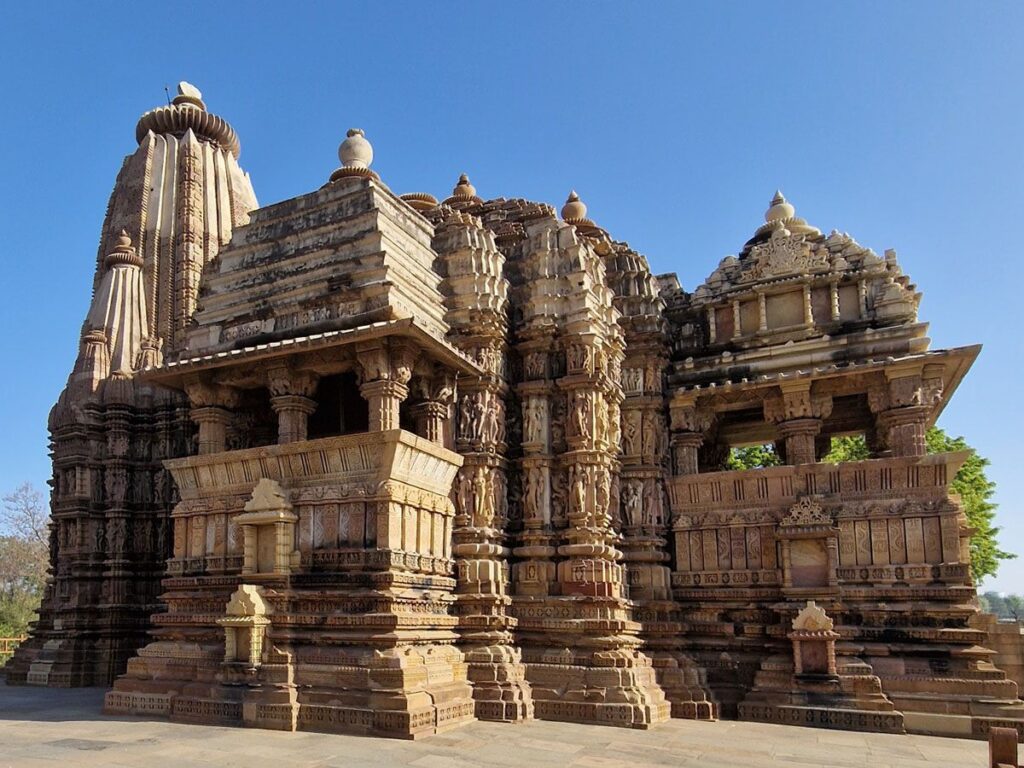
Contents
- 1 Khajuraho Temple History:
- 2 Architecture of Khajuraho Temple:
- 3 Khajuraho Temple Art:
- 4 Significance of Khajuraho Temple:
- 5 Myths of Khajuraho Temple:
- 6 Khajuraho Temple Timing:
- 7 Video and Photography at Khajuraho Temple:
- 8 Places to visit near Khajuraho Temple:
- 9 FAQ:
- 10 How to reach Khajuraho Temple:
- 11 Google Maps:
Khajuraho Temple History:
The Khajuraho temples boast a rich history, dating back to the Chandela dynasty which ruled central India between 9th and 12th centuries AD. Here’s a glimpse into their past:
- Thriving Era (9th-12th Century AD): The Chandela kings, particularly Yashovarman and Dhanga, were responsible for the construction of most of these temples. The period between 950 and 1050 AD witnessed a flurry of activity, resulting in a complex of 85 temples spread over a vast area.
- Architectural Marvels: Built in the Nagara style, these temples are a beautiful blend of architecture and sculpture. The intricate carvings and depictions on the friezes are a testament to the artistic prowess of the era. While some temples are dedicated to Hindu deities like Shiva and Vishnu, others belong to Jainism, showcasing religious tolerance during the Chandela reign.
- Lost and Found (16th Century Onwards): By the 16th century, Khajuraho faded into obscurity and the temples were gradually swallowed by the jungle. It wasn’t until the 19th century that British explorers like T.S. Burt “rediscovered” this forgotten gem, bringing it back to the world’s attention.
Read More>> Magnificent Ramanathaswamy Temple: A Marvel of Architecture
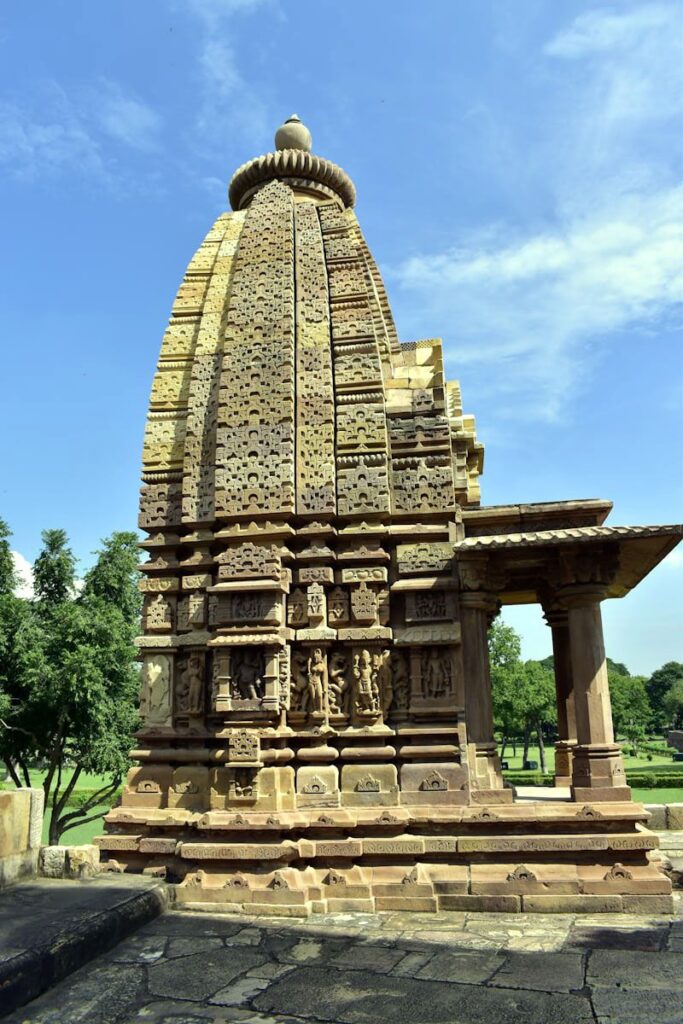
Architecture of Khajuraho Temple:
The Khajuraho Group of Monuments is a collection of stunning Hindu and Jain temples in Khajuraho, a town in the Indian state of Madhya Pradesh. These temples are renowned for their exquisite architecture, intricate sculptures, and intricate carvings. Here’s an overview of the architecture of Khajuraho Temple:
- Style: The temples at Khajuraho were built between 950 and 1050 CE during the Chandela dynasty. They showcase the Nagara style of temple architecture, which is characterized by its towering spires (shikharas) and intricate carvings.
- Layout: The temples are divided into three geographical groups: the Western, Eastern, and Southern groups. The Western group, which is the largest and most famous, houses some of the most significant temples.
- Shikharas: The most prominent feature of Khajuraho temples is their elaborately carved shikharas or spires. These spires rise above the sanctum sanctorum (garbhagriha) of each temple and are intricately adorned with sculptures of gods, goddesses, mythical creatures, and celestial beings.
- Mandapas: The temples typically have mandapas or pillared halls in front of the sanctum sanctorum. These halls were used for various rituals, ceremonies, and gatherings. The mandapas are also adorned with intricate carvings depicting scenes from Hindu mythology, everyday life, and erotic sculptures.
- Sculptures: One of the most striking features of Khajuraho Temple architecture is its intricate sculptures. The temples are adorned with thousands of sculptures depicting various aspects of life, including gods and goddesses, celestial nymphs (apsaras), dancers, musicians, mythical creatures, animals, and erotic scenes. These sculptures are intricately carved with remarkable detail and precision, showcasing the artistic prowess of the craftsmen of that era.
- Erotic Sculptures: While Khajuraho temples are known for their elaborate depictions of Hindu deities and mythology, they are equally famous for their erotic sculptures. These erotic carvings adorn the outer walls of some temples, portraying various aspects of human sexuality in a highly artistic and aesthetic manner. These sculptures are often interpreted as symbolic representations of the celebration of life, fertility, and the union of male and female principles in Hindu philosophy.
- Material: The temples are primarily constructed using sandstone, which was readily available in the region. The sandstone not only provided a durable building material but also served as an excellent medium for intricate carving.
Read More>> Sri Puri Jagannath Temple: The Lord of the Universe
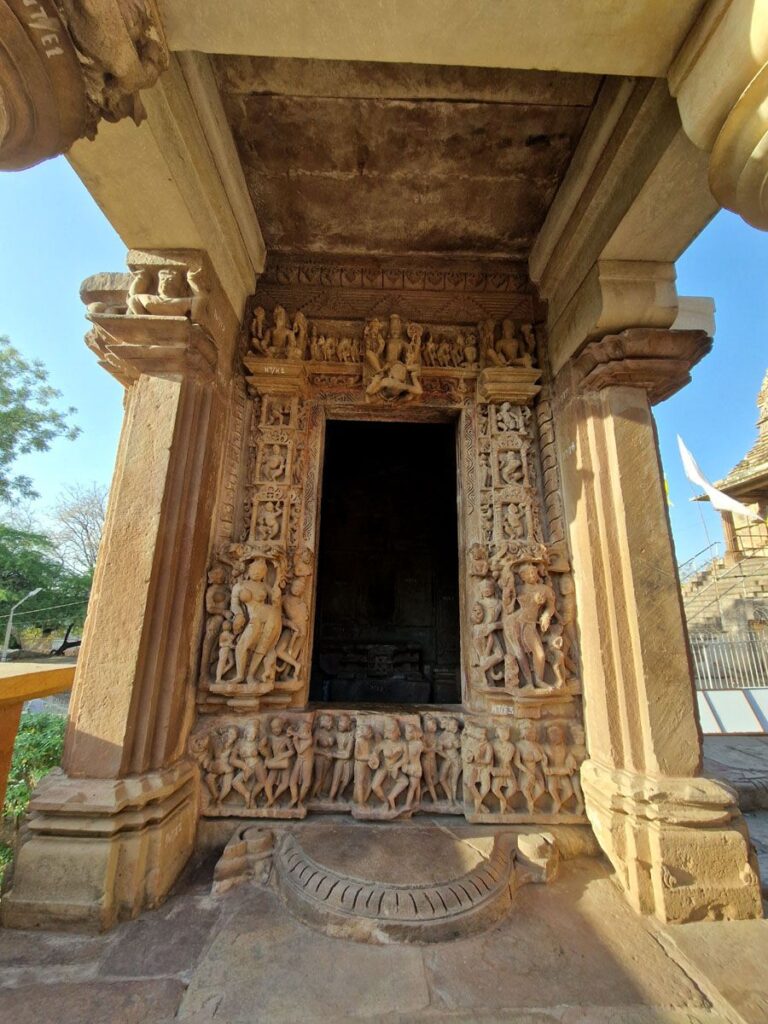
Khajuraho Temple Art:
- Sculptures: The temples of Khajuraho are adorned with thousands of sculptures, each meticulously carved with intricate detail. These sculptures depict a wide range of subjects, including gods and goddesses from Hindu mythology, celestial beings such as apsaras (celestial nymphs), mythical creatures, animals, and human figures engaged in various activities.
- Erotic Sculptures: Perhaps the most famous aspect of Khajuraho temple art is its erotic sculptures. These carvings, which adorn the outer walls of some temples, depict various aspects of human sexuality in a highly artistic and aesthetic manner. While these sculptures have often been a subject of fascination and intrigue, they are also interpreted as symbolic representations of the celebration of life, fertility, and the union of male and female principles in Hindu philosophy.
- Symbolism: Many of the sculptures at Khajuraho temples are rich in symbolism, conveying deeper spiritual and philosophical meanings. For example, the sculptures of gods and goddesses often depict them in various poses and gestures (mudras), each carrying specific symbolic significance related to their divine attributes and roles in Hindu mythology.
- Apsaras and Celestial Beings: A prominent feature of Khajuraho temple art is the depiction of apsaras, or celestial nymphs, who are believed to inhabit the heavens and entertain the gods with their beauty and dance. These graceful figures are often portrayed in intricate dance poses, adorned with elaborate jewelry and flowing garments.
- Narrative Panels: Along with individual sculptures, the temple walls also feature narrative panels depicting scenes from Hindu mythology, epic tales such as the Mahabharata and Ramayana, and everyday life. These panels often unfold elaborate stories, allowing visitors to immerse themselves in the mythological narratives and cultural ethos of ancient India.
- Architectural Ornamentation: In addition to sculptures, Khajuraho temples are adorned with elaborate architectural ornamentation, including intricate carvings on pillars, lintels, and doorways. These decorative elements enhance the overall beauty and grandeur of the temples, creating a visually stunning environment for worship and contemplation.
- Artistic Style: The art of Khajuraho temples reflects a fusion of various artistic styles and influences, including the indigenous Indian tradition, as well as influences from the Gupta and Pratihara dynasties. The sculptures exhibit a remarkable balance of realism and idealism, with an emphasis on graceful forms, expressive faces, and dynamic poses.
Read More>> Jwala Ji Temple Jwalamukhi Kangra

Significance of Khajuraho Temple:
Historical and Architectural Marvel: Built between 950 and 1050 AD by the Chandela dynasty, the temples are a remarkable display of the Nagara style of temple architecture. Their intricate carvings and harmonious design earned them a place on the UNESCO World Heritage List in 1986.
Religious Tolerance: The temples are dedicated to both Hinduism and Jainism, signifying a tradition of religious acceptance during the Chandela rule.
Window into Chandela Dynasty: The temples offer valuable insights into the art, culture, and belief systems of the Chandela dynasty. The sculptures depict various aspects of life, including deities, rituals, and everyday activities.
Artistic Legacy: The Khajuraho sculptures are renowned for their beauty and detail. While some are erotic, most depict a range of subjects including spiritual teachings, daily life, and various gods and goddesses.
Read More>> Kanya Ashram Kanyakumari Temple
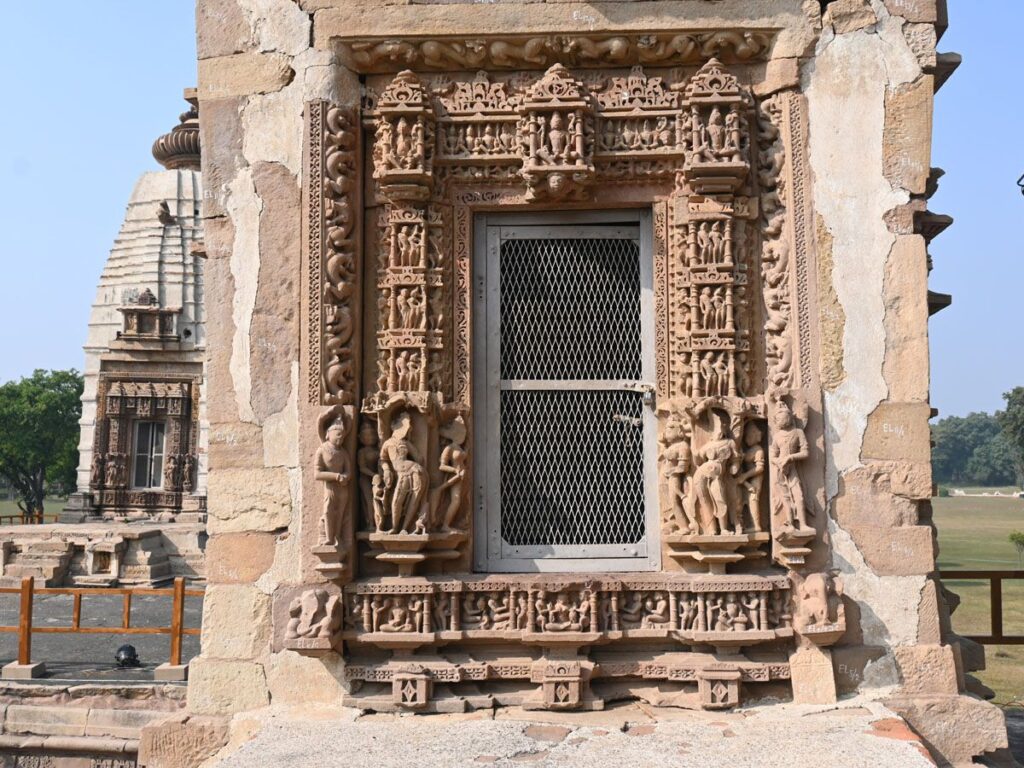
Myths of Khajuraho Temple:
The Khajuraho temples are famous for their stunning architecture and intricate carvings, but one aspect gets a lot more attention than others: the erotic sculptures. This has led to some myths about the temple’s purpose. Here are two:
- Myth 1: The temples were built to celebrate sexuality.
While the erotic carvings are there, they only make up about 10% of the total sculptures [Indian Eagle]. The rest depict scenes from daily life, mythology, and religious figures. Historians believe the erotic art served a symbolic purpose, perhaps representing fertility, cosmic energy, or the importance of pleasure in a balanced life.
- Myth 2: The carvings were meant to be sex education for young men.
This is another misconception. There’s no evidence the temples were restricted to any one group, and the carvings are quite detailed. It’s more likely they were meant for everyone, as a celebration of human experience.
Khajuraho Temple Timing:
The Khajuraho Temples are open all days of the week, with timings varying slightly across different groups:
- Western Group: 6:00 AM to 6:00 PM
- Eastern Group: 8:00 AM to 6:00 PM
- Southern Group: 8:00 AM to 6:00 PM
Read More>> Brihadeeswarar Temple: Timeless Marvel of Chola Architecture
Video and Photography at Khajuraho Temple:
Photography regulations at Khajuraho Temple can be a bit tricky. Here’s a breakdown of what you can and cannot capture:
- No photography of erotic sculptures: This is a strict rule enforced by the Archaeological Survey of India (ASI) that manages the temples. The famed erotic sculptures are what Khajuraho is most known for, but capturing them on camera is strictly prohibited.
- Photography of the temple exterior and other carvings are allowed: You can freely take pictures of the majestic exteriors of the temples, the landscapes around the temples, and the many other carvings that depict deities, floral designs, and geometric patterns.
Here are some tips for capturing great photos at Khajuraho Temple:
- Golden hour lighting: Aim to visit the temples early in the morning or later in the afternoon when the natural light is soft and warm. This will help you capture the intricate details of the carvings and the rich colors of the sandstone.
- Framing: With so much detail to take in, consider using close-up shots to focus on specific carvings or wider shots to capture the entire facade of a temple.
- HDR: HDR (High Dynamic Range) photography can be very effective at Khajuraho as it can help you capture the details in both the highlights and shadows of the sculptures.
Places to visit near Khajuraho Temple:
- Panna National Park: Located around 45 kilometers from Khajuraho, Panna National Park is a renowned tiger reserve and wildlife sanctuary. It offers opportunities for wildlife safaris, where visitors can spot tigers, leopards, sloth bears, deer, and various species of birds amidst lush greenery and scenic landscapes.
- Raneh Falls: Situated around 20 kilometers from Khajuraho, Raneh Falls is a natural wonder known for its stunning canyon formed by the Ken River. The falls cascade down a series of rocky cliffs, creating a mesmerizing sight, especially during the monsoon season when the water flow is at its peak.
- Ken Gharial Sanctuary: Also located near Raneh Falls, Ken Gharial Sanctuary is dedicated to the conservation of the critically endangered gharial, a species of crocodile. Visitors can take boat rides on the Ken River to observe these reptiles in their natural habitat, along with other aquatic species such as turtles and fish.
- Beni Sagar Dam: Situated just a few kilometers from Khajuraho, Beni Sagar Dam is a popular picnic spot and recreational area. The dam offers scenic views of the surrounding countryside and provides opportunities for boating, fishing, and birdwatching.
- Dhubela Museum: Located around 64 kilometers from Khajuraho, Dhubela Museum is housed in an ancient fort and showcases a fascinating collection of artifacts, sculptures, and historical exhibits related to the Bundelkhand region’s rich heritage and cultural traditions.
- Ajaygarh Fort: Situated approximately 80 kilometers from Khajuraho, Ajaygarh Fort is a historic fortification dating back to the Chandela dynasty. It offers panoramic views of the surrounding landscape and provides insights into the region’s architectural and military history.
- Pandav Falls and Caves: Located around 35 kilometers from Khajuraho, Pandav Falls is a scenic waterfall surrounded by lush greenery. Nearby, visitors can explore the Pandav Caves, a series of ancient rock-cut caves believed to have been inhabited by the Pandavas during their exile.
FAQ:
- What is Khajuraho Temple?
- Khajuraho Temple refers to a group of Hindu and Jain temples located in the town of Khajuraho in the Indian state of Madhya Pradesh. These temples are renowned for their stunning architecture and intricate sculptures.
- When were Khajuraho Temples built?
- The Khajuraho Temples were built between 950 and 1050 CE during the Chandela dynasty.
- How many temples are there in Khajuraho?
- Originally, there were around 85 temples in Khajuraho, but only about 25 of them have survived to the present day.
- What is the architectural style of Khajuraho Temples?
- The temples at Khajuraho are built in the Nagara style of temple architecture, characterized by their towering spires (shikharas), intricate carvings, and elaborate ornamentation.
- What are the main attractions of Khajuraho Temple?
- The main attractions of Khajuraho Temple include its exquisite sculptures, both religious and erotic, depicting various gods, goddesses, mythical creatures, and scenes from Hindu mythology. The architectural beauty and intricate detailing of the temples are also major highlights.
- Are Khajuraho Temples UNESCO World Heritage Sites?
- Yes, the Khajuraho Group of Monuments, which includes the temple complex, has been designated as a UNESCO World Heritage Site since 1986.
- Why are there erotic sculptures at Khajuraho Temples?
- The erotic sculptures at Khajuraho Temples are believed to symbolize the celebration of life, fertility, and the union of male and female principles in Hindu philosophy. They are also considered a reflection of the cultural and social ethos of medieval India.
- How can I reach Khajuraho Temple?
- Khajuraho is well-connected by air, rail, and road. Visitors can reach Khajuraho by taking a flight to Khajuraho Airport, a train to Khajuraho Railway Station, or a bus or car via road networks.
- What are some nearby attractions to visit along with Khajuraho Temple?
- Nearby attractions to visit along with Khajuraho Temple include Panna National Park, Raneh Falls, Ken Gharial Sanctuary, Beni Sagar Dam, Dhubela Museum, Ajaygarh Fort, and Pandav Falls and Caves.
- Is there an entry fee to visit Khajuraho Temple?
- Yes, there is an entry fee for visiting the Khajuraho Temple complex. The fee may vary for Indian and foreign tourists. Additionally, there may be separate charges for accessing certain sections or temples within the complex.
How to reach Khajuraho Temple:
- By Air:
- Khajuraho Airport (IATA: HJR) is located around 4 kilometers from the town center.
- It operates regular flights to and from major cities like Delhi, Mumbai, Varanasi, and Agra.
- After arriving at the airport, travelers can hire taxis or use local transportation to reach Khajuraho Temple.
- By Train:
- Khajuraho Railway Station (Station code: KURJ) is situated approximately 5 kilometers from the town center.
- It is well-connected to cities like Delhi, Agra, Varanasi, and Jhansi through regular trains.
- Some popular trains serving Khajuraho include the Khajuraho Express, Utkal Express, Mahakaushal Express, and Bundelkhand Express.
- From the railway station, travelers can avail taxis, auto-rickshaws, or local buses to reach Khajuraho Temple.
- By Road:
- Khajuraho is well-connected to nearby cities and towns by road networks.
- State-run buses operated by Madhya Pradesh Tourism Development Corporation (MPTDC) and private bus operators offer regular services to Khajuraho from cities like Delhi, Jaipur, Agra, Varanasi, and Jhansi.
- Additionally, taxis and private cars can be hired for a more comfortable and convenient journey.


